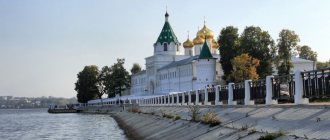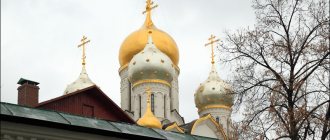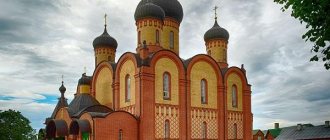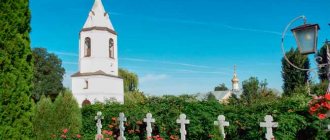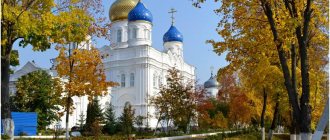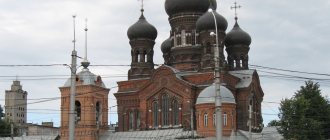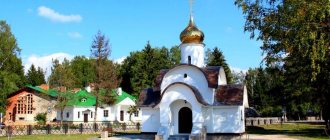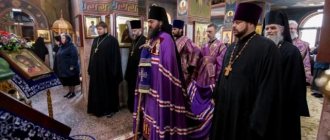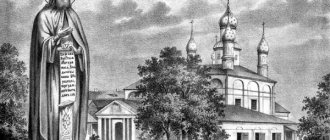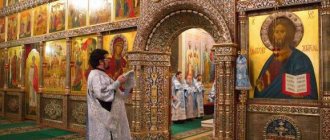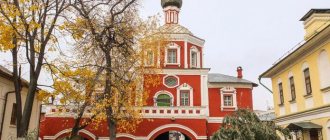Most of the guests of Kostroma strive to visit the Epiphany-Anastasia Convent, but the monastery has walled itself off from worldly affairs and, apparently, has its own reasons for this. Tourists are only allowed to enter the Epiphany Cathedral, where you can see the miraculous Theodore Icon of the Mother of God, revered since the times of ancient Rus', and venerate it, as well as the Smolensk Chapel with the fresco icon of the Smolensk Mother of God. Ordinary citizens are not allowed access to the rest of the territory.
A visit to the main monastery shrine is included in most Golden Ring of Russia excursion programs.
Complex of the Epiphany-Anastasia Monastery
The monastery belongs to the Kostroma diocese of the Russian Orthodox Church. Within its borders there are churches, two hotels for pilgrims and out-of-town clergy, a theological seminary, a rectory with a refectory and diocesan services, an orphanage for girls and an almshouse.
Abbot's corps, © Slav Yakounin
In plan, the territory of the monastery has a broken trapezoidal shape, and along the perimeter it is surrounded by a stone and partially wooden fence, as well as buildings facing the red line. The entrance gates are located on Pyatnitskaya Street and at the bell tower, and the entrance to the Cathedral and Smolensk Church is from Simanovsky Street.
Epiphany-Anastasia Cathedral
The temple is the main one in the Kostroma diocese and the oldest surviving church building of the monastery. It was erected in 1559–65. and presumably painted by masters of Guri Nikitin’s artel in the middle of the 17th century. Their work has not survived, but after the monastery buildings returned to the fold of the Russian Orthodox Church in 1990, the walls and ceiling vaults of the temple were decorated with polychrome frescoes.
Paintings of the cathedral vaults, © pavlovamarina1
In 1864, the ancient building was expanded by adding a lower church to it. It was originally made of red brick and stood out against the backdrop of the elegant white cathedral. In the basement in 1867, a temple was built for the Venerable Sergius of Radonezh and his disciple Nikita of Kostroma. In a hidden place here rest the holy relics of Nikita of Kostroma, the founder of the Epiphany Monastery in Kostroma, revered among the saints.
The Epiphany-Anastasia Cathedral received cathedral status in August 1991.
Smolensk Church
The chapel was erected in 1824–25. based on the corner southwestern tower located here. At that time, the rector of the Epiphany Monastery was the Altai missionary, the Monk Macarius, and the money for construction was allocated by Kostroma resident F. Obryadchikov. The church was consecrated in the name of the miraculous icon of the Smolensk Mother of God. A copy of it in the form of a fresco was created on the wall of the southwestern tower of the monastery wall in 1672 by icon painters from the Guri Nikitin artel.
Smolensk chapel-church, © Eduard Skvortsov
During the severe fire of 1779, which completely destroyed the monastery, the image of the Mother of God remained unharmed. The fresco icon was not damaged in 1847, when two-thirds of Kostroma burned down. In those days, believers went en masse to the Smolensk chapel to ask the Mother of God for protection, and the flames receded. As a sign of gratitude, the wall icon was decorated with a gilded silver chasuble, which was removed and confiscated by local authorities in the 1920s.
The fresco of the Smolensk Mother of God, which survived the fires, almost disappeared during the “godless” years. By 1990, only outlines remained of it, but restorers managed to restore the ancient image. In 2004, the rescued icon was decorated with a new precious chasuble.
The image of Our Lady of Smolensk helps to protect yourself from illnesses and troubles along the way, and to protect your home from ill-wishers and enemies.
Bell tower
The square passage tower on the western side of the monastery fence was built over an octagonal tier, covered with a tent and turned into a bell tower. The Holy Gates passed under it, through which today you can enter the stone gallery, built during the restoration of the monastery in the 19th century. It opens a direct path to the cathedral from the street and limits access to the monastery for unauthorized persons.
Bell tower and entrance to the cathedral, ©
Monument to Theodore Stratelates
The statue of the great martyr in chain mail, with a shield, sword and icon in his hands was installed in the monastery courtyard in 2002. Theodore Stratelates is considered the patron saint of Kostroma and the Christian army, and is also indirectly related to the main shrine of the Epiphany-Anastasia convent - the ancient Theodore icon of the Mother of God.
Statue of Theodore Stratilates in the monastery courtyard, © Metropolis of Kostroma Vkontakte
Architectural monuments
The most important building is the Epiphany Cathedral. It was built in the fourteenth century and is considered the second major religious building in Kostroma. In fact, now this cathedral is the oldest building that has survived intact into modern times. The temple is based on a four-pillar plan, the facades are decorated with zakomaras. Scientists are convinced that the construction of this structure was supervised by Moscow masters. The appearance of the temple changed from century to century, largely due to the large number of extensions. The most significant changes occurred to the temple in the sixty-fourth year of the nineteenth century.
We recommend reading:
The most beautiful places in Crimea
Epiphany Cathedral
The territory of the monastery includes the Smolensk Church, which is dedicated to the icon of the same name. It has one chapter, a very beautiful facade. At first the church was built in the classical style, but it was destroyed by fire, after which the building was restored using the Russian-Byzantine style.
Smolensk Church Kostroma
Feodorovskaya Icon of the Mother of God
The first mention of an icon with a similar spelling dates back to the 12th century. They indicate that the shrine could have been located in one of the chapels of Gorodets, and then in the monastery founded on its site. After the destruction of the city by Batu's troops in 1238, the icon disappeared, so they decided that it burned down during a fire started by the Mongols. However, it was found again, as evidenced by several legends, differing only in the dates and names of the princes who found it. One of the legends says that with this icon the father of Alexander Nevsky blessed the marriage of his son with his first wife, the daughter of Prince Bryachislav of Polotsk.
Feodorovskaya Icon of the Mother of God, © Dmitry Remezov
Researchers consider the Feodorovskaya Icon of the Mother of God to be a copy of the more ancient Vladimir Icon, but there is no consensus on its origin. Many attribute the authorship to the Evangelist Luke, and he, as is known, lived in the 1st century. The image of the Mother of God received its name thanks to the vision of the Great Martyr Theodore Stratilates that appeared at the moment of the second discovery of the shrine.
Feodorov’s image of the Mother of God became one of the shrines of the Romanov house, since in 1613 it was with this icon that the mother blessed her son Mikhail Fedorovich, the first in the royal Romanov dynasty, to the sovereign throne. From the end of the 18th century. the brides of the Grand Dukes of the Romanovs, coming to Russia and converting to Orthodoxy, chose their patronymic name Fedorovna.
Since 1891, the icon was decorated with a gold frame weighing 10 kg, which the atheistic authorities requisitioned in 1922. Until 1944, it was owned by renovationists; since 1964, it was located in the Kostroma Church of the Resurrection on Debra, which at that time served as a cathedral. In 1991, the image was transferred to the Epiphany-Anastasia Monastery. Today, the safety of the Feodorovskaya Icon of the Mother of God is assessed as extremely low, and its reverse side with the image of the martyr Paraskeva is assessed as satisfactory.
Procession of the Cross, © Metropolis of Kostroma
In the church calendar, the holiday in honor of the Theodore Icon of the Mother of God is assigned to two dates - March 27 and August 29. On these days a religious procession is held. Accompanied by singing and the ringing of bells, the image is carried in the hands through the streets of Kostroma, after which a festive prayer service is performed in a crowded place.
The Feodorovskaya Icon of the Mother of God patronizes girls and women and helps brides find a worthy life partner. She is asked to ease childbirth, find long-awaited children, and be cured of illnesses.
Abbots
Monastery:
- Macarius (Kuchin) (1618 - 1624)
- Haggai (Kolosovsky) (1771 - 1773)
- Macarius (Glukharev) (1821 - 1824)
- Evgeny (Bazhenov) (September 15, 1824 - 1829)
- Afanasy (Drozdov) (July 27, 1829 - 1837)
- Platon (Gorodetsky) (December 20, 1837 - 1839)
- Nathanael (Savchenko) (May 5, 1839 - 1845)
- Agafangel (Soloviev) (September 21, 1845 - February 19, 1849)
Convent:
- Innocentia (Travina) (mentioned 2014)
Story
The men's monastery was founded at the turn of the XIV-XV centuries. student of Sergius of Radonezh - Nikita Kostroma. All buildings were then erected from wood, and only in 1559, on the initiative of Abbot Isaiah, the first stone building was laid here - the Epiphany Cathedral. Large sums of money were donated for its construction by the grandson of the sovereign of all Rus' Ivan the Great and the cousin of the first crowned Tsar Ivan the Terrible, appanage prince Vladimir Staritsky. 10 years later, he was executed according to a conspiracy, and a year later the same fate would befall the Epiphany monks led by Isaiah.
In the XVI century. Two women's monasteries were assigned to the monastery - the Anastasia Monastery, named in honor of its founder Anastasia, daughter of Alexander Donskoy, and the Holy Cross Monastery. After the state abolition of the monastic estates, they merged into a single Anastasia-Krestovozdvizhensky Monastery.
Onion heads, © Alexey Zadonsky
XVII century, despite the plunder of the Epiphany Monastery by the troops of False Dmitry of the II century. 1608 was marked by extensive construction. At this time, new temples, service buildings, stone towers and a massive fence 7 m high appeared.
In 1847, the Epiphany Monastery burned down and was abolished. Kostroma residents affected by the fire began to dismantle stone buildings to restore their homes, as a result of which many buildings of the complex were irretrievably lost. 16 years later, the Holy Synod allowed the remaining ruins to be annexed to the adjacent monastery, after which the monastery began to be called Epiphany-Anastasia. The complex began to be revived in 1863 thanks to the efforts of Mother Superior Maria. The next devastating fire occurred in 1887.
Monastery wall with bell tower (Simanovsky St.), © Alexey Panin
In 1918–19 The monastery was closed and the sisters went their separate ways. In the next 10 years, the walls, towers and several temples were destroyed, the cemetery was liquidated, and the surviving buildings were used as an archive, a club, a museum, a biological station and a hospital. The area was surrounded by residential buildings. In 1981, during another fire, the Epiphany Cathedral was damaged and frescoes from the 17th century were destroyed. In 1991, the monastery came to life again. Nuns from the Pukhtitsa Assumption Monastery came here, and soon services began.
The patronal feast of the Epiphany-Anastasia Monastery is celebrated on January 4, the day of memory of Anastasia the Pattern Maker.
Schedule of services at the Epiphany Cathedral
On weekdays morning services usually start at 07:30, on weekends at 08:30. Evening services are held at 17:00. Holiday and Sunday services are headed by the Metropolitan of the Kostroma Diocese.
© Kostroma Metropolis VKontakte
Epiphany-Anastasiin Monastery: schedule of Metropolitan services on the official website
Entrance to the Epiphany Anastasia Monastery: panorama on google.maps
How to get to the Epiphany-Anastasiin Monastery
The nearest stop “Bogoyavlensko-Anastasiin Cathedral” is served by buses No. 2 and 57. You can get to the stop “Pyatnitskaya Street”:
- by buses - No. 1, 48, 56, 81, 99, 105, 107, 109, 387;
- minibuses - No. 21;
- trolleybuses - No. 2, 7, 9.
Kostroma public transport map and online routes
Popular mobile taxi apps Gett, Maxim, Vezet (Rutaxi), Yandex Go work in Kostroma. To create your own travel option, you can use this convenient website.
Epiphany-Anastasia Monastery: video
Description of the architecture
The appearance of the monastery complex has undergone many changes in its lifetime. His yard resembles an elongated trapezoid. The oldest building that has survived to our time is the Epiphany Cathedral. It is distinguished by its restrained appearance.
The roof of the temple is crowned with onion-shaped golden domes. There is a basement below.
Currently, on the territory of the monastery there is also a bell tower, the Church of the Smolensk Icon of the Mother of God and the Cathedral of the Epiphany. Before the revolution, there was the Baroque St. Nicholas Church, the Cathedral of St. John the Evangelist and the Church of the Three Saints.
